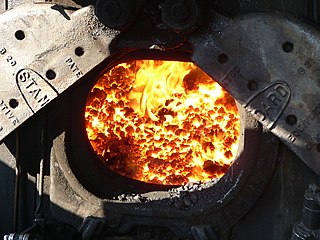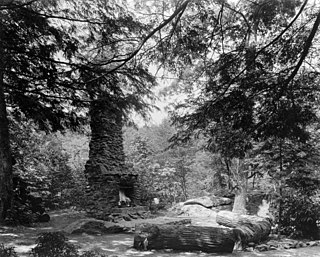
A fire brick, firebrick, or refractory brick is a block of refractory ceramic material used in lining furnaces, kilns, fireboxes, and fireplaces. A refractory brick is built primarily to withstand high temperature, but will also usually have a low thermal conductivity for greater energy efficiency. Usually dense firebricks are used in applications with extreme mechanical, chemical, or thermal stresses, such as the inside of a wood-fired kiln or a furnace, which is subject to abrasion from wood, fluxing from ash or slag, and high temperatures. In other, less harsh situations, such as in an electric or natural gas fired kiln, more porous bricks, commonly known as "kiln bricks" are a better choice. They are weaker, but they are much lighter, easier to form, and insulate far better than dense bricks. In any case, firebricks should not spall, and their strength should hold up well during rapid temperature changes.

A fire-tube boiler is a type of boiler in which hot gases pass from a fire through one or (many) more tubes running through a sealed container of water. The heat of the gases is transferred through the walls of the tubes by thermal conduction, heating the water and ultimately creating steam.

In a steam engine, the firebox is the area where the fuel is burned, producing heat to boil the water in the boiler. Most are somewhat box-shaped, hence the name. The hot gases generated in the firebox are pulled through a rack of tubes running through the boiler.

The GWR 4100 Class was a class of steam locomotives in the Great Western Railway (GWR) of the United Kingdom.

The Belpaire firebox is a type of firebox used on steam locomotives. It was invented by Alfred Belpaire of Belgium in 1864. Today it generally refers to the shape of the outer shell of the firebox which is approximately flat at the top and square in cross-section, indicated by the longitudinal ridges on the top sides. However, it is the similar square cross-section inner firebox which provides the main advantages of this design i.e. it has a greater surface area at the top of the firebox where the heat is greatest, improving heat transfer and steam production, compared with a round-top shape.

The GER Class L77, LNER Class N7, is a class of 0-6-2T steam locomotives. They were designed by Alfred John Hill of the Great Eastern Railway and introduced in 1915. The design was perpetuated by Nigel Gresley of the LNER after the 1923 grouping. 134 were built; only one of them is preserved.

A masonry heater is a device for warming an interior space through radiant heating, by capturing the heat from periodic burning of fuel, and then radiating the heat at a fairly constant temperature for a long period. The technology has existed in different forms, from back into the Neoglacial and Neolithic periods. Archaeological digs have revealed excavations of ancient inhabitants utilizing hot smoke from fires in their subterranean dwellings, to radiate into the living spaces. These early forms have evolved into modern systems.

An outdoor fireplace is a place for building fires outside of the home. Similar in construction to an indoor fireplace, an outdoor fireplace is usually added to a stone, brick, or concrete patio. It often consists of a firebox and a chimney. The firebox is typically constructed with a smoke shelve incorporated although straight firebox designs are not uncommon since chimney draft is not always a concern for an outdoor fireplace. As with indoor fireplaces, an outdoor fireplace requires cleaning and maintenance to keep it looking and working at its best. While an outdoor fireplace may not need to be cleaned as often, it will need to be cleaned regularly in order to keep it reasonably tidy and maintained and to remove ash build.

An electric fireplace is an electric heater that mimics a fireplace burning coal, wood, or natural gas. Electric fireplaces are often placed in conventional fireplaces, which can then no longer be used for conventional fires. They plug into the wall, and can run on a "flame only" setting, or can be used as a heater, typically consuming 1.4-1.6 kW, that can heat a 400 sq ft (37 m2) room.

The Wythe House is a historic house on the Palace Green in Colonial Williamsburg, in Williamsburg, Virginia, USA. Built in the 1750s, it was the home of George Wythe, signer of the Declaration of Independence and father of American jurisprudence. The property was declared a National Historic Landmark on April 15, 1970.

A wood-burning stove is a heating appliance capable of burning wood fuel and wood-derived biomass fuel, such as sawdust bricks. Generally the appliance consists of a solid metal closed firebox, often lined by fire brick, and one or more air controls. The first wood burning stove was patented in Strasbourg in 1557, two centuries before the Industrial Revolution, which would make iron an inexpensive and common material, so such stoves were high end consumer items and only gradually spread in use.
The B VIII steam engines of the Royal Bavarian State Railways were tender locomotives.
Gloria was a central heating system used in Castile beginning in the Middle Ages. It was a direct descendant of the Roman hypocaust, and due to its slow rate of combustion, it allowed people to use smaller fuels such as hay instead of wood.

The South African Railways Class 8E 4-8-0 of 1903 was a steam locomotive from the pre-Union era in the Cape of Good Hope.

A coal shovel is a shovel designed for shoveling coal, coke or similar fuels, and on occasions does a double duty removing ash from the fireplace, firebox or furnace.
A direct vent fireplace is a prefabricated metal fireplace that employs a direct-vent combustion system. "Direct vent" refers to a sealed-combustion system in which air for combustion is drawn from the outdoors, and waste combustion gasses are exhausted to the outdoors. "Direct vent" does not simply mean that all gasses from combustion are vented to the exterior of the structure in which it is installed.

The South African Railways Class 16DA 4-6-2 of 1930 was a steam locomotive.

















